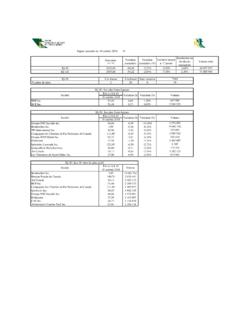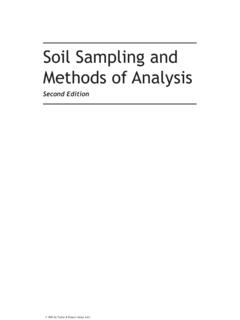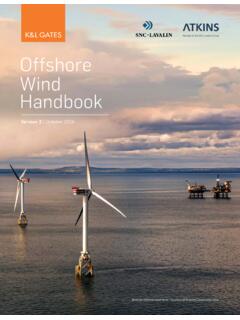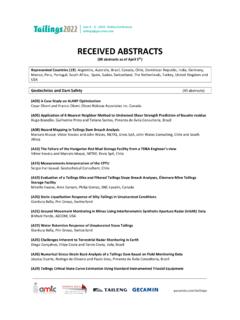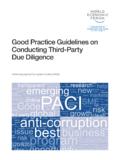Transcription of Ethics & Compliance HANDBOOK - TEI
1 Ethics & Compliance HANDBOOK . Liezl Groenewald and Guendalina Dond SUPPORTED THIS PROJECT FINANCIALLY. Authors: Liezl Groenewald and Guendalina Dond . Editorial support: Prof Deon Rossouw and Philippa Foster Back CBE. Cover design and layout: Lilanie Greyling (Dezinamite Visual Solutions). Publishing Editor: Monia Wadham (IBE). Ethics and Compliance HANDBOOK The Ethics Institute (TEI) 2017 and Institute of Business Ethics (IBE) 2017. ISBN 978-0-620-75268-8 printed copy ISBN 978-0-620-75491-0 electronic copy Published by: The Ethics Institute Hadefields Office Park Block E, 1267 Pretorius Street, Hatfield, Pretoria, South Africa Website: Contact: The Copyright is the Creative Commons Copyright It means: The Ethics Institute grants the right to download and print the electronic version, to distribute and to transmit the work for free, under three conditions: 1) Attribution: The user must attribute the bibliographical data as mentioned above and must make clear the license terms of this work.
2 2) Non-commercial: The user may not use this work for commercial purposes or sell it. 3) No change of text: The user may not alter, transform or build upon this work. Nothing in this license impairs or restricts the author's moral rights. The Ethics Institute reserves intellectual property rights of materials and processes generated by ourselves prior to or during the completion of this study. This includes (but is not limited to) consultation processes, research instruments and reporting methodologies. Ethics & Compliance HANDBOOK . Liezl Groenewald and Guendalina Dond SUPPORTED THIS PROJECT FINANCIALLY. Acknowledgements A number of people have been helpful in producing this HANDBOOK . The authors are grateful to the TEI and IBE teams for their support and advice.
3 In particular, Deon Rossouw (TEI Chief Executive Officer) and Philippa Foster Back (IBE Director). contributed practical help and advice on the content and style of this publication. The authors are particularly thankful to all those who agreed to be interviewed for this HANDBOOK and provided their input and expertise: Graham Brunton (Group Ethics and Compliance Manager at Tullow Oil), Robert Smith (Director of Business Compliance and Ethics at Serco), Peter Montagnon (Associate Director at IBE), Osama (Sam) Al Jayousi (Group Compliance Manager at Carillion) and Philip Jordan (Chairman of the Ethics Committee at Total). The authors are very grateful to them and others who have been supportive. Other publications in The Ethics Institute's HANDBOOK series, available at The Social and Ethics Committee HANDBOOK (2012).
4 The Ethics Reporting HANDBOOK (2014). The Ethics Risk HANDBOOK (2016). Table of Contents Acknowledgements Foreword by The Ethics Institute 2. Foreword by the Institute of Business Ethics 3. Recognition of sponsorship: SNC-Lavalin 4. INTRODUCTION 5. About this HANDBOOK 6. Who is this HANDBOOK for? 8. Standardisation of terminology 8. PART 1: SETTING THE CONTEXT 9. Ethics and Compliance : conceptual differences 10. Values and rules 11. PART 2: DIFFERENT SIDES OF THE SAME COIN? 14. The origins and development of the Ethics and Compliance role 15. The respective responsibilities of Ethics and Compliance practitioners 17. Similarities in roles and responsibilities 19. Dissimilarities in roles and responsibilities 20. Focus 21. Different skills sets 22.
5 Different mindsets and approaches 23. Shared challenges 26. An 'image' problem 26. External stakeholder trust in business 27. Getting the message heard at the top table 27. The risk of combining Ethics and Compliance 28. PART 3: WORKING TOGETHER 30. Collaboration at the governance level 32. The governing body 32. Governing body committees 36. Collaboration at the operational level 42. What a productive collaboration looks like 45. CONCLUSION 46. About The Ethics Institute 49. About the Institute of Business Ethics 50. About the authors 51. PAGE 1. Foreword by The Ethics Institute Both unethical and illegal conduct can cause organisations great harm, and jeopardise their sustainability. Consequently, responsible organisations have been implementing measures to protect themselves against illegal and unethical conduct.
6 Sometimes organisations opt for combining their defence against unethical and illegal conduct in one management function. This publication assesses whether it is prudent to combine the Ethics function and the Compliance function in organisations, or whether it is better to maintain Ethics and Compliance as separate, though complementary functions. The Ethics and Compliance HANDBOOK forms part of the Ethics HANDBOOK Series of The Ethics Institute. These handbooks are intended to provide those responsible for governing and managing Ethics in organisations with useful and practical guidance. Since the governance and management of Ethics can never be isolated from other management functions in organisations, the Ethics HANDBOOK Series explores the interface and collaboration between Ethics management and other management functions in this case, the interaction between the Ethics and Compliance functions in organisations.
7 As with all previous Ethics handbooks, The Ethics Institute has partnered with one of its strategic partners that has an interest in the theme of the specific HANDBOOK . In the case of The Ethics and Compliance HANDBOOK , we have opted for partnering with the Institute of Business Ethics (based in London). In 2016 The Ethics Institute and the Institute of Business Ethics signed a Memorandum of Understanding that provides for various forms of collaboration. The Ethics and Compliance HANDBOOK is the first fruit of that collaboration. I would like to thank the Director of the Institute of Business Ethics , Philippa Foster Back, for her unwavering support to this project. Furthermore, I would like to thank the co- authors of the book for their dedication and hard work to produce this very useful and much needed guidance on the Ethics and Compliance interface.
8 Liezl Groenewald from The Ethics Institute acted as the project leader, and was very ably supported by Guendalina Dond from the Institute of Business Ethics . I trust that The Ethics and Compliance HANDBOOK will help organisations around the globe to create positive synergy between the Ethics and Compliance functions in their mutual pursuit of protecting their organisations against the risks of unethical and illegal conduct. Prof Deon Rossouw CD (SA). CEO: The Ethics Institute Ethics AND Compliance HANDBOOK | Foreword PAGE 2. Foreword by the Institute of Business Ethics The international perspective this HANDBOOK gives on Ethics and Compliance and the management of the two functions is a timely insight. It is an often debated topic at IBE.
9 Events and in our advisory practice, as companies of all nationalities and in all sectors often struggle as to how they should run these important business functions. Those companies that are regulated often see Compliance as pre-eminent. Yet many have come to recognise that to build a positive corporate culture it is important to establish the right mindset. That mindset, which should be based on an ethical framework of corporate values to guide decisions and behaviours, will be encouraged by the creation of a separate Ethics function and will lead to better Compliance as a result. As this HANDBOOK illustrates, the two functions cannot work in isolation and need to collaborate closely with each other and with other departments, given the centrality of Ethics to a business within a defined governance framework.
10 Through the work of the King Committee and recently in the King IV Report on Corporate Governance for South Africa 2016 this is set out. In the UK, the UK Corporate Governance Code is not currently prescriptive as to all companies being required to have a code of Ethics or board level committee to oversee its embedding. These matters are currently being debated. The Institute of Business Ethics is pleased to have collaborated with The Ethics Institute on this HANDBOOK , and I thank and congratulate Liezl and Guen on this publication. Philippa Foster Back CBE. Director, Institute of Business Ethics PAGE 3. Recognition of Sponsorship: SNC-Lavalin The Institutes would like to thank SNC-Lavalin for its generous sponsorship towards the research, design and printing of this publication.
